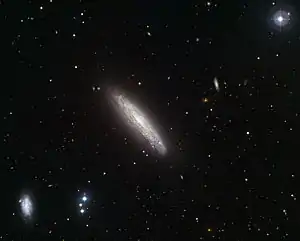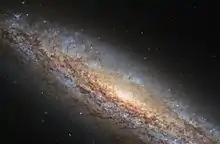| NGC 4666 | |
|---|---|
 The superwind galaxy NGC 4666 | |
| Observation data (J2000 epoch) | |
| Constellation | Virgo |
| Right ascension | 12h 45m 08.676s[1] |
| Declination | −00° 27′ 42.88″[1] |
| Heliocentric radial velocity | 1,517 km/s[2] |
| Distance | 54.89 ± 0.65 Mly (16.83 ± 0.20 Mpc)[3] |
| Apparent magnitude (V) | 10.8[4] |
| Characteristics | |
| Type | SABc[2] |
| Apparent size (V) | 4′.6 × 1'.3[2] |
| Notable features | Starburst |
| Other designations | |
| NGC 4666, IRAS F12425-0011, MCG+00-33-008, MRC 1242-001, PMN J1245-0027, UGC 7926, UZC J124508.0-002744, PGC 42975[5] | |
NGC 4666 is a spiral galaxy in the equatorial constellation of Virgo, located at a distance of approximately 55 megalight-years from the Milky Way.[3] It was discovered by the German-born astronomer William Herschel on February 22, 1784. It is a member of the Virgo II Groups, a series of galaxies and galaxy clusters strung out from the southern edge of the Virgo Supercluster.[6] John L. E. Dreyer described it as "bright, very large, much extended 45°±, pretty suddenly brighter middle".[7] It is a member of an interacting system with NGC 4668 and a dwarf galaxy,[8] and belongs to a small group that also includes NGC 4632.[2]
The morphological classification of this galaxy is SABc, which indicates a weak bar around the nucleus with moderately wound spiral arms. Viewed nearly edge-on, its galactic plane is inclined at an angle of 85°±2° to the line of sight from the Earth, with the major axis aligned along a position angle of 40°. There is an active galactic nucleus that shows a modest level of activity and is most likely heavily obscured by gas and dust. The central point source has been detected in the radio and X-ray bands.[2]
This is a starburst galaxy that is noteworthy for its vigorous star formation, which creates an unusual superwind[9] of out-flowing gas. This wind is not visible at optical wavelengths, but is prominent in X-rays, and has been observed by the ESA XMM-Newton space telescope.[10] The estimated star formation rate is 7.3 M☉ yr–1, with a density of 8.9×10−3 M☉ yr−1 kpc−2. Unlike in many other starburst galaxies, the star formation is spread across the disk rather than being more concentrated.[2]
Three supernovae have been observed in NGC 4666. On 23 May 1965, Enrique Chavira discovered SN 1965H (type IIP, mag. 14).[11] A type Ia supernova was detected in NGC 4666 on 9 December 2014;[12][13] ASASSN-14lp is located 12″ from the center of NGC 4666. A type Ib supernova, SN 2019yvr, was detected on 27 December 2019.[14] It has a 0.005 redshift. Images of the location of the supernova before the explosion showed the progenitor star was ~19M☉.[15]

References
- 1 2 Skrutskie, Michael F.; Cutri, Roc M.; Stiening, Rae; Weinberg, Martin D.; Schneider, Stephen E.; Carpenter, John M.; Beichman, Charles A.; Capps, Richard W.; Chester, Thomas; Elias, Jonathan H.; Huchra, John P.; Liebert, James W.; Lonsdale, Carol J.; Monet, David G.; Price, Stephan; Seitzer, Patrick; Jarrett, Thomas H.; Kirkpatrick, J. Davy; Gizis, John E.; Howard, Elizabeth V.; Evans, Tracey E.; Fowler, John W.; Fullmer, Linda; Hurt, Robert L.; Light, Robert M.; Kopan, Eugene L.; Marsh, Kenneth A.; McCallon, Howard L.; Tam, Robert; Van Dyk, Schuyler D.; Wheelock, Sherry L. (1 February 2006). "The Two Micron All Sky Survey (2MASS)". The Astronomical Journal. 131 (2): 1163–1183. Bibcode:2006AJ....131.1163S. doi:10.1086/498708. ISSN 0004-6256. S2CID 18913331.
- 1 2 3 4 5 6 Stein, Y.; et al. (March 2019). "CHANG-ES. XIII. Transport processes and the magnetic fields of NGC 4666: indication of a reversing disk magnetic field". Astronomy & Astrophysics. 623: 21. arXiv:1901.08090. Bibcode:2019A&A...623A..33S. doi:10.1051/0004-6361/201834515. A33.
- 1 2 Tully, R. Brent; et al. (October 2013), "Cosmicflows-2: The Data", The Astronomical Journal, 146 (4): 25, arXiv:1307.7213, Bibcode:2013AJ....146...86T, doi:10.1088/0004-6256/146/4/86, S2CID 118494842, 86
- ↑ "The Interactive NGC Catalog Online". Results for NGC 4666. Retrieved 2010-09-21.
- ↑ "NGC 4666". SIMBAD. Centre de données astronomiques de Strasbourg. Retrieved 2020-09-22.
- ↑ "The Virgo III Groups". Atlas of the Universe. Retrieved 2010-11-27.
- ↑ Seligman, Courtney. "New General Catalogue objects: NGC 4650 - 4699". cseligman.com. Retrieved 2020-09-20.
- ↑ Walter, Fabian; et al. (May 2004). "The Superwind Galaxy NGC 4666: Gravitational Interactions and the Influence of the Resulting Starburst on the Interstellar Medium". The Astrophysical Journal. 606 (1): 258–270. Bibcode:2004ApJ...606..258W. doi:10.1086/382774.
- ↑ "The Superwind Galaxy". ESO. 1 September 2010.
- ↑ "Extra-planar Hot Gas and Magnetic Fields in the Superwind Galaxy NGC 4666". ESA. 24 February 2011. Archived from the original on 22 October 2014. Retrieved 24 February 2011.
- ↑ Transient Name Server entry for SN 1965H. Retrieved 23 March 2023.
- ↑ "ASAS-SN Discovery of A Bright Probable Supernova in NGC 4666". Astronomer's Telegram.
- ↑ "Supernovae ASASSN-14lp in NGC 4666". Rochester Astronomy.
- ↑ "SN 2019xvr". Transient Name Server.
- ↑ Kilpatrick, Charles; et al. (2021-03-30). "A Cool and Inflated Progenitor Candidate for the Type Ib Supernova 2019yvr at 2.6 Years Before Explosion". Monthly Notices of the Royal Astronomical Society. 504 (2): 2073–2093. arXiv:2101.03206. doi:10.1093/mnras/stab838.
External links
- SEDS: NGC 4666
- The Superwind Galaxy NGC 4666, ESO Press Release.